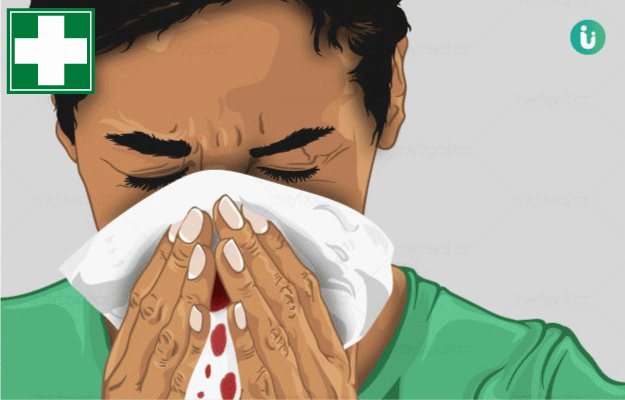Nosebleed, medically known as epistaxis, is usually harmless and not a very serious condition in most people. It is common in children and people above 50 years of age. Except in those with bleeding and clotting disorders such as haemophilia, a nosebleed is rarely seen after puberty. Bleeding from the nose commonly occurs from within the nose near the nose tip (anterior region).
Dryness in the nose; exposure to cold dry air such as in winter; injury caused by frequent nose picking, especially in children; trauma; sinusitis; and nasal polyps (fleshy mass inside the nose) are some of the most common causes of nosebleed. Other less common, systemic or deep-rooted causes that require immediate medical attention include high blood pressure; a tumour; abnormality in the partition wall inside the nose (for example: nasal septal defect); bone deformity; genetically inherited disorders related to blood clotting, such as haemophilia A and B; and von Willebrand disease. Another rare genetic condition called hereditary haemorrhagic telangiectasia (delicate blood vessels prone to bleeding on slightest injury) is also associated with nosebleeds. Certain conditions with decreased elasticity or inflammation in the wall of blood vessels present with nosebleed (for example arteriosclerosis, collagen disorder).
Bleeding from the nose is generally painless unless associated with injury. Headache, pain, and other symptoms may be present when nosebleed occurs due to high blood pressure, congestive heart failure or injury. A majority of nosebleeds without a definite cause do not need medicines and would resolve with traditional treatment alone. Doctors commonly manage nosebleed by the application of pressure by pinching the nose (below the nose bridge), nasal packs, and saline solutions. Cauterisation is carried out when nasal packing and other conservative treatment measures fail to stop bleeding. Nosebleeds due to a specific reason need medicines to treat the underlying causes (for example high blood pressure). Surgery is recommended when nosebleed fails to stop after medical and traditional treatments and when bleeding occurs from bigger arteries that supply blood to the nose.

 Doctors for Nosebleed
Doctors for Nosebleed  OTC Medicines for Nosebleed
OTC Medicines for Nosebleed
 Nosebleed articles
Nosebleed articles

 First Aid for Nosebleed
First Aid for Nosebleed
 Home Remedies for Nosebleed
Home Remedies for Nosebleed
 Homeopathic Treatment of Nosebleed
Homeopathic Treatment of Nosebleed

































 Dr. Srishti Gupta
Dr. Srishti Gupta

 Dr. Rachita Narsaria
Dr. Rachita Narsaria

 Dr. Laxmidutta Shukla
Dr. Laxmidutta Shukla











